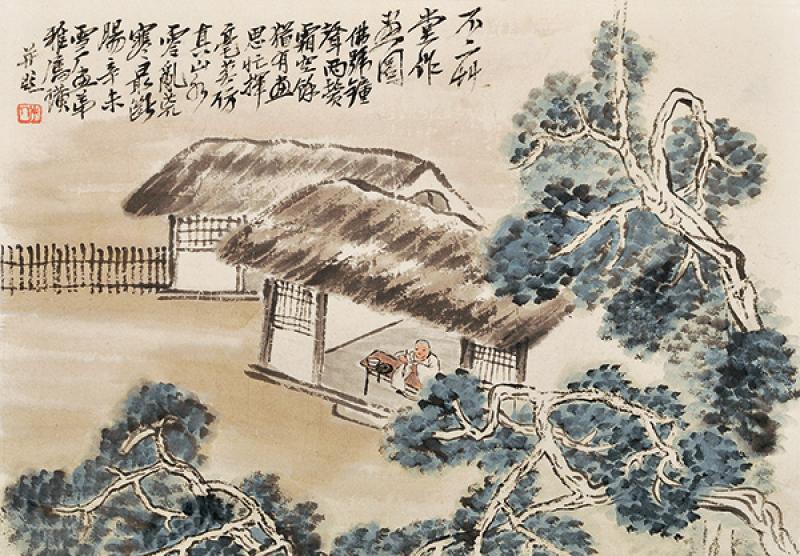Drawn to each other
By: No Author Indicated

Drawn to each other

An ongoing exhibition showcases paintings, calligraphic pieces and seal impressions by Qi Baishi.[Photo Provided to China Daily]
The items on display come from the collections of the Fine Art Academy and the Beijing Xu Beihong Memorial Hall.
One of the earliest works on show is Xun Jiu Tu (Recollections of the Past), produced in about 1933, in which Qi painted his own back and left an inscription of how his association with Xu began, and how much he missed the time they spent together.
In the inscription, Qi mentioned Xu, who was then appointed as the head of the Beiping Fine Art College (renamed the Central Academy of Fine Arts in the 1950s), paid several visits to his home in 1928, and persuaded him to accept a professorship at the college.

An ongoing exhibition showcases paintings, calligraphic pieces and seal impressions by Qi Baishi.[Photo Provided to China Daily]
An exhibition at the Beijing Fine Art Academy showcases the friendship between Xu Beihong and Qi Baishi, two leading artists in 20th-century China. Lin Qi reports.
The friendship between Xu Beihong (1895-1953) and Qi Baishi (1864-1957), two eminent artists of 20th-century China, demonstrates how despite different perspectives about art, they trusted and supported each other.
Their 25-year relationship which continued until Xu's death expanded from art to day-to-day life. An exhibition at the Beijing Fine Art Academy showcases this unique relationship.
The exhibition titled Qi Baishi, in the Eyes of Xu Beihong, brings together dozens of paintings, calligraphic pieces and seal impressions by Qi, as well as letters exchanged by the duo.

An ongoing exhibition showcases paintings, calligraphic pieces and seal impressions by Qi Baishi.[Photo Provided to China Daily]
Qi at first turned down the offer because of his age and also because of the fear of opposition from conservatives at the school.
Qi, who referred to himself as "an insignificant painter", used to survive doing carpentry in his native rural Hunan province, and had for long been marginalized by Beijing's art circles.
But, Qi was moved by Xu's sincerity, and took up his offer. And they became great friends.
Xu Qingping, 72, the son of Xu Beihong and director of the Xu Beihong Memorial Hall, says it surprised many at the time that a close relationship could be formed between two people who had an age gap of 31 years, and who differed a lot when it came to education and social status.

Letters exchanged by Qi and Xu Beihong.[Photo Provided to China Daily]
Xu Qingping says: "Qi was not trained at a formal art college-a key reason why he was discriminated against by the conservatives-while my father had studied at the prestigious Ecole Nationale Superieure des Beaux-Arts in Paris, and had lived in Europe for eight years in the 1920s. Besides, he had also taught at several art colleges after returning to China."
However, Xu Qingping says it was not surprising that the two became friends, because both were talented and appreciated each other. And more importantly, they shared a passion to free Chinese ink painting from rigid, formalist doctrines, and make it more accessible to ordinary people, although they adopted different approaches.
"He (Xu Beihong) was one of the few people who recognized Qi's versatility."
The friendship deepened despite the fact that Xu soon resigned from his post-followed by Qi a short while later-as his reforms at the college sparked conflict between his supporters and the conservatives.

An ongoing exhibition showcases paintings, calligraphic pieces and seal impressions by Qi Baishi.[Photo Provided to China Daily]
Meanwhile, besides frequently exchanging letters, Xu became an avid collector of Qi's artworks; and he spared no effort to promote Qi's art when traveling at home and abroad, according to Hua Tianxue, a senior researcher at the Chinese National Academy of Arts in Beijing.
She says Xu started collecting Qi's works soon after they got to know each other, but Xu never asked for lower prices just because they were friends.
She adds that Xu also introduced Qi's art to other collectors. When Xu traveled and exhibited his own works, he often carried around and showed his collection of Qi's paintings.
Xu had more than 100 of Qi's artworks, which cover almost every motif in Qi's oeuvre.

The items on display, including Xun Jiu Tu, come from the collections of the Fine Art Academy and the Beijing Xu Beihong Memorial Hall.[Photo Provided to China Daily]
Hua says Qi's works formed the bulk of pieces collected by Xu, and he collected them not for private appreciation, but because he anticipated the building of public galleries where these pieces could be displayed.
Xu's collection of Qi's works later became part of the Xu Beihong Memorial Hall's trove, and the bulk of them are now on show at the exhibition at the Fine Art Academy.
After Qi died, his family donated dozens of his artworks to the country, and the works formed the first collection of the academy.
In 1946, Xu returned to the Beiping Fine Art College which he headed until his death. And, he also invited Qi back to teach.
Hua says Qi, who was then in his 80s, lectured once a week, and Xu escorted him back home each time.

An ongoing exhibition showcases paintings, calligraphic pieces and seal impressions by Qi Baishi.[Photo Provided to China Daily]
A letter Xu wrote to Qi in the 1950s exemplifies Xu's thoughtfulness as a young admirer and close friend. The letter was delivered to Qi's home together with a fresh herring and a dozen zongzi (rice dumplings).
In the letter, Xu told Qi not to take off the fish scales because they contained oils which were nutritious, and added that the fish tasted most delicious when steamed.
When Xu died, Qi was not told about it for fear that the aged artist would not be able to handle the sad news.
Qi learnt of his friend's death a year later when he visited Xu's residence which had by then been transformed into a memorial hall.
It is said that Qi then stood still in front of a photo of Xu, bowed deeply, and said farewell to his friend amid a flood of tears.
Tags
Who is online
29 visitors



Not only are the works of art a fine example of a style rebellious of the conservative art mavens at the time, the early 20th century, but the story of the relationship between the elder artist and a younger aficionado is quite special..
Will be linking this article to the Three-day Weekend Feature.
I really like this artwork. The relationship between the two is interesting, opposites in many ways.